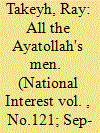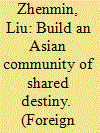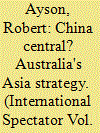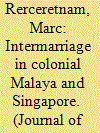|
|
|
Sort Order |
|
|
|
Items / Page
|
|
|
|
|
|
|
| Srl | Item |
| 1 |
ID:
123644


|
|
|
|
|
| Publication |
2012.
|
| Summary/Abstract |
MORE THAN thirty years after Ayatollah Ruhollah Khomeini came to power-and two decades after his passing-the Islamic Republic remains an outlier in international relations. Other non-Western, revolutionary regimes eventually eschewed a rigidly ideological foreign policy and accepted the fundamental legitimacy of the international system. But Iran's leaders have remained committed to Khomeini's worldview. The resilience of Iran's Islamist ideology in the country's foreign policy is striking. China's present-day foreign policy isn't structured according to Mao's thought, nor is Ho Chi Minh the guiding light behind Vietnam's efforts to integrate into the Asian community. But Iran's leadership clings to policies derived largely from Khomeini's ideological vision even when such policies are detrimental to the country's other stated national interests and even when a sizable portion of the ruling elite rejects them.
|
|
|
|
|
|
|
|
|
|
|
|
|
|
|
|
| 2 |
ID:
080574


|
|
|
|
|
| Publication |
2007.
|
| Summary/Abstract |
This article is an attempt to provide a corrective to a marked Sinocentrism in contemporary debates on regional integration in Asia. In order to do so, firstly, as a heuristic device, a crucial distinction is made between 'regionalization', as involving multifaceted integrative socio-economic processes, and 'regionalism', defined as a form of identity construction akin to nationalism. Secondly, a degree of historical depth is proposed to better explain recent developments. Finally, throughout the article, an interdisciplinary approach is taken involving employing realist, historical/sociological institutionalist and constructivist perspectives in the area of international relations. The first two East Asian summits are contextualized in relation to various conceptualizations of an Asian Community over the last century or so. Particular attention is given to the 1955 Asian-African Conference in Bandung as a watershed in this evolution. Varying conceptions of East Asia as part of a larger, transpacific regional entity (APEC) and in, and of, itself (East Asian Economic Group/ASEAN +3) are examined. In situating the first two East Asian summits five developments of significance are examined. These are: a continuing Japanese role in setting the regional agenda; the ambivalence of China's positioning vis-à-vis neighbouring countries; the re-entry of Central Asia in the Asian regional equation; India's 'return to Asia'; and efforts to maintain ASEAN's centrality in regional construction. These factors, it is argued, are militating towards a return to the Sino-Indic Asia of Bandung. It is thus suggested that notions of an Asian Community involving only Northeast and Southeast Asia are now rejoined by a concept of a Greater Asia. While the historical roots of this conception partly explain its salience, it nevertheless competes with other complementary - and antagonistic - definitions of an Asian Community of more recent lineage
|
|
|
|
|
|
|
|
|
|
|
|
|
|
|
|
| 3 |
ID:
128315


|
|
|
|
|
| Publication |
2013.
|
| Summary/Abstract |
As a member of Asia, China's development is rooted in Asia, and Asia has always been a priority on China's diplomatic agenda. China's growth has benefited from a peaceful neighboring area and, in turn, promoted stability and prosperity in Asia. At the same time, China and its neighbors are faced with both historic opportunities and challenges in development. Since the new government in China took office in 2013, China and other Asian countries have had frequent high-level exchanges and stronger cooperation in the field of economy and trade. China actively upholds peace and stability in the region and is working with other Asian countries to build a bright future for an Asian community of shared destiny.
|
|
|
|
|
|
|
|
|
|
|
|
|
|
|
|
| 4 |
ID:
089146


|
|
|
|
|
| Publication |
2009.
|
| Summary/Abstract |
From Australia's perspective, and in spite of the global economic crisis, an increasingly strong China will remain the dominant theme in Asia's evolving distribution of power. Australia has benefited from the prosperity which is the foundation of China's rise. But it continues to value the reassurance that a strong United States can bring to Asia. This favourable status quo seems superior to the alternatives: a cooperative Asian community which may be more aspirational than practicable; an Asian concert which requires an unlikely sharing of leadership between the great powers; or a coalition of Asian democracies which could be especially divisive. But as this comfortable status quo is strained, Australia may need to consider geopolitical options which until now have appeared fanciful and risky.
|
|
|
|
|
|
|
|
|
|
|
|
|
|
|
|
| 5 |
ID:
117188


|
|
|
|
|
| Publication |
2012.
|
| Summary/Abstract |
Colonial race relations are regularly portrayed in light of the attempts to divide and rule colonialised Asian communities. While this article does not challenge this view, it attempts to uncover a hitherto hidden level of interaction and even intermarriage at the grassroots level in colonial Malaya and Singapore. With the exception of the various Peranakan communities that predated British rule, little to no evidence exists to show that interaction and especially intermarriage existed within early first- and second-generation migrant communities during the British colonial period. The findings show how colonial attempts to encourage a heightened sense of race and its frailties may have fallen short among some sections of the Asian community.
|
|
|
|
|
|
|
|
|
|
|
|
|
|
|
|
| 6 |
ID:
111549


|
|
|
|
|
| Publication |
2012.
|
| Summary/Abstract |
Revolving around the concept of 'Community' or 'community', debate on an Asian region has ostensibly pitted those who proposed an entity limited to East Asia (China, Japan, South Korea and the ten countries of the Association of South East Asian Nations, ASEAN) against those who proposed a much wider region embracing India, North (and, perhaps, South) America, as well as Australasia. Previously these two conceptualisations possessed their eponymous translation in the East Asian Economic Caucus (reincarnated as ASEAN+3) and the Asia Pacific Economic Cooperation forum. However, with the creation in 2005 of the East Asian Summit to include India, Australia and New Zealand and, above all, its 2011 enlargement to include the United States and Russia, the contrast between the two conceptualisations of an Asian region has become confused. In order to explain this development, this article suggests that the language of 'region' or 'community' is a discursive smokescreen disguising changes in approaches to multilateralism. An examination of the East Asia Summit, contrasting it with another recent regional project, the Trans Pacific Partnership, suggests that the actors involved are seeking to ensure the primacy of individual nation states in intergovernmental multilateral relations.
|
|
|
|
|
|
|
|
|
|
|
|
|
|
|
|
|
|
|
|
|